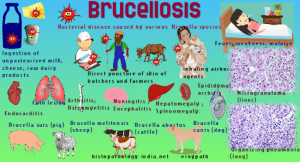Brucellosis In Animals – Animal Husbandry Notes – For W.B.C.S. Examination.
Brucellosis is a contagious disease of livestock with significant economic impact.Continue Reading Brucellosis In Animals – Animal Husbandry Notes – For W.B.C.S. Examination.
The disease is caused by various bacteria of the family Brucella, which tend to infect a specific animal species. However, most species of Brucella are able to infect other animal species as well.
It affects cattle, swine, sheep and goats, camels, equines, and dogs. It may also infect other ruminants, some marine mammals and humans.
The disease in animals is characterized by abortions or reproductive failure. While animals typically recover, and will be able to have live offspring following the initial abortion, they may continue to shed the bacteria.
Brucellosis in cattle (B. abortus) in sheep and goats (B. melitensis) and in swine (B. suis) are diseases listed in the World Organisation for Animal Health (OIE) Terrestrial Animal Health Code and must be reported to the OIE (Terrestrial Animal Health Code).
Transmission and spread
Brucellosis is typically spread when the animal aborts or gives birth. High levels of bacteria are found in the birth fluids of an infected animal. The bacteria can survive outside the animal in the environment for several months, particularly in cool moist conditions. They remain infectious to other animals which become infected by ingesting the bacteria. The bacteria also colonise the udder and contaminate the milk.
The disease can also infect animals and humans through cuts in the skin, or through mucous membranes.
Brucellosis is an important disease in wildlife, infecting feral pigs, bison, elk and European hares. The reservoir of disease in wildlife complicates eradication efforts.
The bacteria have also been found in marine mammals.
Public health risk
Brucellosis is a zoonosis highly infectious for humans causing a disease often called undulant fever or Malta fever, since it was fi rst recognised in Malta during the 1850s.
Symptoms in humans include intermittent or irregular fever, headache, weakness, profuse sweating, chills, weight loss and general aching. Infections of organs including the liver and spleen may also occur.
Veterinarians, farmers, and abattoir workers are vulnerable to infection as they handle infected animals and aborted fetuses or placentae.
Brucellosis is one of the most easily acquired laboratory infections, and strict safety precautions should be observed when handling cultures and heavily infected samples, such as products of abortion.
The disease can also spread to people through consumption of unpasteurised milk coming from infected animals.
Clinical signs
Typically the disease is mild, with the infected animal showing few signs until she aborts. There may be swelling of the testicles in males, and occasionally the bacteria localizes in the joints causing arthritis.
In horses, it causes a condition called fi stulous withers or poll evil, a swelling of the neck or back. However pregnant mares may either abort or give birth to weak and vulnerable foals.
The importance of Brucellosis is that it causes poor reproductive performance, due to abortions, infertility, retention of placenta, stillbirth or birth of weak offspring. It results in huge economic losses to dairy, sheep, goat and pig farmers.
Diagnostic
The disease may be suspected based on clinical signs such as abortions, but confirmation is made through serological tests, then with prescribed laboratory tests to isolate and identify the bacteria, following the guidelines describing the methods and diagnostic thresholds in the OIE .
Prevention and control
Surveillance using serological tests, as well as tests on milk like the milk ring test, can be used for screening and play an important role in campaigns to eliminate the disease. As well individual animal testing both for trade and for disease control purposes is practiced.
In endemic areas, vaccination is often used to reduce the incidence of infection. Several vaccines are available that use modified live viruses. The OIE Manual of Diagnostic Test and Vaccines for Terrestrial Animals provides detailed guidance on the production of vaccines.
As the disease is closer to being eliminated, a test and stamping out program is required to completely eliminate it.
Human brucellosis is best prevented by controlling the infection in animals. Pasteurisation of milk from infected animals was an important way to reduce infection in humans.
Geographical distribution
The highest incidence is observed in the Middle East, the Mediterranean region, sub-Saharan Africa, China, India, Peru, and Mexico. Currently, countries in central and southwest Asia are seeing the greatest increase in cases.
Several countries in Western and Northern Europe, Canada, Japan, Australia and New Zealand are believed to be free from the agent.
Please subscribe here to get all future updates on this post/page/category/website


 Toll Free 1800 572 9282
Toll Free 1800 572 9282  mailus@wbcsmadeeasy.in
mailus@wbcsmadeeasy.in



















































































































